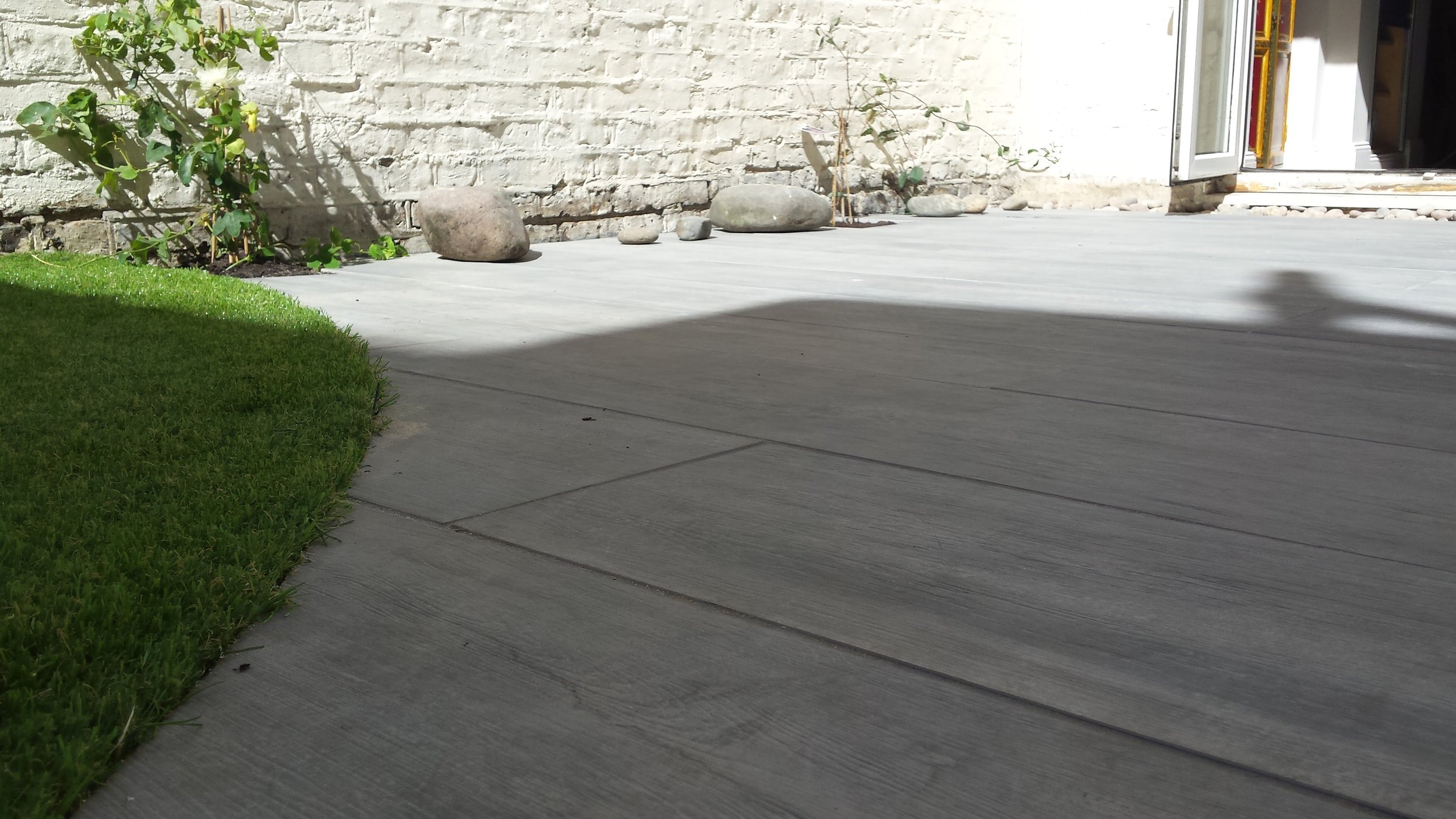
Complete Guide to Garden Paving
In this post I’m going to show you how to choose, install and maintain garden paving.
In fact I have been in this game for 15 years now and installed hundreds of patios for my clients. I have noticed that the biggest challenge is right at the beginning - what paving slabs to choose?
Don’t worry, in this guide I will help you understand:
Types of paving slabs
How to choose garden paving by colour
How to choose garden paving by stone type
How to build a patio
How to choose paving grout
How much patio cost
How to clean a patio
Types of paving slabs
When it comes to patio slabs types, we can highlight two categories. Man-made and natural stone slabs. At first when you are just starting your journey with paving, you may think there are very similar. And actually you’d be right. Visually they are - but only when new.
Man-made paving
Man-made paving can be split into two groups. Coloured concrete and porcelain paving.
Concrete paving - how is it made?
Generally a concrete is mixed with dyes to achieve desired colour and then is placed into moulds that often replicate natural stone appearance. The designs can be endless. From riven surface, so they look like quarried natural stone to polished and perfectly smooth.
Because concrete slabs are manufactured, we get a huge range of colours. Budget slabs may have a single colour like buff, grey or charcoal but the more expensive can have mixture of colours to mimic more natural appearance.
I’m sure you’ve seen a garden stepping stones that look like a log or animal foot shape. These were definitely concrete slabs.
To summarise concrete slabs:
Pros:
Huge range of colours
Vast shape variations - might be helpful when looking for something specific like curved slabs or round timber logs shape.
Good choice of textures
Some very cheap concrete slabs may not look appealing but are perfect to use for garden shed base. The regular size and thickness makes the installation easier.
Good quality concrete paving will last long time - specially when they’re properly maintained.
Cons:
Coloured paving slabs have added pigments which will fade over time. Most concrete paving will loose it’s original colour within first 5-7 years.
If chipped or cracked, the aggregate is exposed and slab must be replaced. Usually new slab looks very different and stand out of the rest.
Must be continuously sealed to look good
Porcelain Paving
How a porcelain paving is made
Porcelain is manufactured from a blend of high quality clays, quarzitic sands and other minerals such as granite which are then baked in a high-temperature kiln.
There is a lot of preparation required before the unbaked 'biscuit' can be sent into the kiln, and then there's a fair bit of post-firing work required to ensure that what is sent out to the trade is of a sufficient quality and standard.
All porcelain manufacturers are using the same procedure but the ingredients and quantities may differ. First all aggregates are mixed together and are dried with hot to reduce moisture level to just under 8%.
Then blended powder is pressed into moulds and dried again. Now the moisture content is only around 1%.Once pressed, the porcelain tiles will receive it’s final pattern and texture. These are printed onto the surface. Porcelain tile can have appearance of granite, travertine, sandstone or even timber planks.
The final step is firing. Tiles progress through the kiln with temperature reaching 1,200°C then is gradually cooled.
To summarise porcelain slabs:
Pros:
Extremely durable and low-maintenance, each paver is built to last. They require very little upkeep and have the ability to retain their vibrancy and unblemished finish for years
Resistant to stains and fading.
Endless possibilities of appearance and textures
Frost resistant
Very accurate sizing. Usually the tolerance is less than 1mm
Cons:
Can be expensive. Prices starts from £40 / m2 right up to over £120
Requires specialist cutting blades
Not for DIY-er. Porcelain does not forgive mistakes. Installer must have a good knowledge about porcelain and be perfectionist. Incorrect installation can lead to expensive repairs.
Natural stone paving
Natural stone paving has been popular for hundreds of years but the recent decades has seen a massive increase in demand. To meet increasing demand, paving stone had to be imported from India, Brazil, China or Egypt.
With growing amount of suppliers, natural stone became cheaper and more households could afford to have natural looking patio.
Indian Sandstone
Indian Sandstone has become the most popular imported stone. It comes in variety of different shades and colours. From greys, browns, greens to golden, orange and reds. It’s important to note that some suppliers offer cheaper prices but their paving slabs are not colour sorted.
For example Fossil Mint Sandstone has variation range of colours from orange through yellow to white. When installed in random pattern this stone would look like a patchwork.
Good supplier should have all the paving sorted by colour tone.
Another point to note is that not all sandstones are equal. The main difference is porosity.
Porosity is simply a void within the stone. The more voids in the stone the more porous it is. More porous means more water absorption. During the hot summer days this may not be a huge problem because water absorbed by paving will quickly evaporate. Problems will start during the colder months, when patio is soaked for weeks. These are perfect conditions for algae growth. Newly installed patio will look awful and very tired after only first few colder weeks.
You probably asking yourself - “yeah, so how do I know which sandstone is good?”
Ok, so porous stone is a lot softer. You can try to crumble the corner with your fingers. If it breaks, don’t buy it.
You can pour some water on the stone. If it soaks in like a sponge, don’t buy it.
Also light coloured paving tend to be more porous.
Low price might be tempting but generally speaking you get what you pay for.
To summarise Sandstone slabs:
Pros:
Available in wide range of colours and sizes
Most of good suppliers provide calibrated paving. It means that the thickness of a patio slabs is consistent throughout the pack. This speeds up installation time and reduces the costs.
Sandstone is often supplied with riven edges which gives a natural look.
Being very popular is also widely available “off the shelf” at competitive price. Sandstone can be bought from as low as £20/m2
Cons:
All sandstones are porous and require maintenance.
Some poor quality pavers will age very quickly.
Stains very easily and are hard to clean.
Not recommended for driveways. Specially light coloured paving.
Limestone Paving
Limestone is another very popular patio stone in the UK. The colour palette is perhaps not as wide as Sandstone but it comes in very dark colours instead. Limestone is consistent in colour and comes in some select colour choices, usually buff-grey, blue-grey and blue-black.
In general, limestone is defined as being composed of calcium carbonate. Calcium carbonate often comes from plant and animal skeletons and remnants including the shells of molluscs.
Limestone is consistent in colour and texture and is considered as hard wearing stone.
It’s usually supplied with straight edges as opposed to riven of sandstone.
Limestone has become very popular in the recent years thanks to it’s dark colour. We have noticed a trend for contrastic colours in recent garden designs. Many garden projects features dark floor with white walls or vice versa.
However there is one thing that many paving suppliers will not tell you.
Limestone fades really quickly when exposed to UV rays. I mean it becomes chalky in just few weeks. Suddenly the contrast you had between patio and wall disappears.
To prevent this, limestone must be sealed as soon as possible. The sealing process may need to be repeated every year, depending what product was used.
Very important advice to remember: NEVER use acid based cleaning products on Limestone.
To summarise Limestone slabs:
Pros:
Pretty good hard wearing stone
Consistent in colour and texture
Contemporary look
Low cost - prices very similar to Sandstone.
Readily available
Easy to work with.
Cons:
Similar to Sandstone, Limestone is porous and will absorb water
If not sealed, it will stains very easily .
Limestone will become chalky within few weeks of installation if not sealed properly.
Slate Paving
Slate paving is considered to be a premium quality paving. Slates are very dense with very low porosity. Slate stone has been used in building industry for decades. Mainly in roofing industry. As the importing became easier, we have started to see more slates being used as a paving material.
Slate paving has a sleek appearance with rich colours. Available in dark blue, green and rustic tones.
Like all other paving, slates can be supplied calibrated but due to a layered structure of that stone, you are likely to may more for calibration.
Slate does not have to be sealed and it holds the colour for years. General maintenance like occasional jet-wash is all that’s needed.
Good quality slate paving can be compared with porcelain in terms of durability and it’s also in the same price range as porcelain tiles.
Although the slate patio installation can be expansive, it’s always seen as an investment.
To summarise Slate slabs:
Pros:
Beautiful rich colours and standout texture
Colour will not fade
Contemporary look
Requires minimal maintenance
Very dense structure and low water absorption
Readily available
Easy to work with.
Cons:
Can be difficult to install if you buy non calibrated slate
Sometimes a layer of slate can flake off and create water pit.
Good quality slate can be expensive






